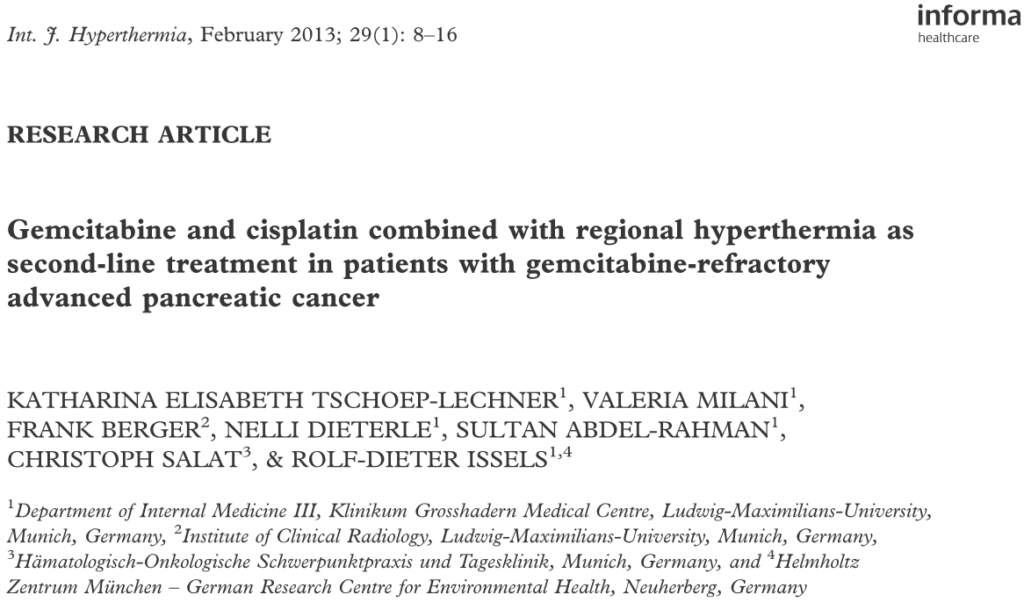Gemcytabina i cisplatyna połączona z hipertermią regionalną jako leczenie drugiej linii pacjentów odpornych na gemcytabinę z zaawansowanym rakiem trzustki
tytuł oryg.: Gemcitabine and cisplatin combined with regional hyperthermia as second-line treatment in patients with gemcitabine-refractory advanced pancreatic cancer
Wydawnictwo: International Journal of Hyperthermia
Autor główny: Katharina Elisabeth Tschoep-Lechner
Pozostali autorzy: Valeria Milani, Fank Berger, Nelli Dieterle, Sultan Abdel-Rahman, Christoph Salat, Rolf-Dieter Issels
Data: 2012-10-13

DOI: 10.3109/02656736.2012.740764
Język publikacji: angielski
Klasa publikacji: Badanie retrospektywne
Rodzaj badania: Jednośrodkowe, Nierandomizowane
Liczba pacjentów: 23
Rodzaj HT: LRHT RF
Rodzaj HT opis: Hipertermia miejscowa głęboka fale radiowe
Aparatura: BSD-2000
Jednostka chorobowa: Zaawansowany rak trzustki
Symbol Jednostki chorobowej: APC
Stage: –
Typ skojarzenia HT stosowany w badaniu: HT + CT
Rodzaj CT: Gemcitabine, Cisplatin
Abstract. Purpose: There is no standard second-line therapy for patients with advanced pancreatic cancer (APC) after gemcitabine (G) failure. Cisplatin (Cis)-based chemotherapy has shown activity in APC. It is proven that cytotoxicity of G and Cis is enhanced by heat exposure at 40 to 42 C. Therefore G plus Cis with regional hyperthermia (RHT) might be beneficial for patients with G-refractory APC.
Patients and methods: We retrospectively analysed 23 patients with advanced (n¼2) or metastatic (n¼21) pancreatic cancer with relapse after G mono first-line chemotherapy (n¼23). Patients had received G (day 1, 1000 mg/m2) and Cis (day 2 and 4, 25 mg/m2) in combination with RHT (day 2 and 4, 1 h) biweekly for 4 months. We analysed feasibility, toxicity, time to second progression (TTP2), overall survival (OS) and clinical response.
Results: Between October 1999 and August 2008 23 patients were treated. Haematological toxicity was low with no grade 4 event. Hyperthermia-associated toxicity consisted of discomfort because of bolus pressure (3%), power-related pain (7%) or position-related pain (17%). Median TTP1 was 5.9 months (95% confidence interval (CI): 2.6–9.2), median TTP2 was 4.3 months (95%CI: 1.2–7.4) and OS 12.9 months (95%CI: 9.9–15.9). The disease control rate in 16 patients with available CT scans was 50%.
Conclusions: We show first clinical data of G plus Cis with RHT being clinically active in G-pretreated APC with low toxicity. A prospective controlled phase II second-line clinical trial (EudraCT: 2005-003855-11) and a randomised phase III adjuvant clinical trial offering this treatment (HEAT; EudraCT: 2008-004802-14) are currently open for recruitment.
Potrzebujesz więcej danych o artykule? Skontaktuj się z PTHO droga mailową.